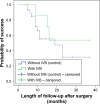Glaucoma drainage device implantation with adjunctive intravitreal bevacizumab in neovascular glaucoma: 3-year experience
- PMID: 28848323
- PMCID: PMC5557098
- DOI: 10.2147/OPTH.S137470
Glaucoma drainage device implantation with adjunctive intravitreal bevacizumab in neovascular glaucoma: 3-year experience
Abstract
Purpose: To evaluate the outcome of glaucoma drainage device (GDD) implantation with and without intravitreal bevacizumab (IVB) injection in treating neovascular glaucoma (NVG) at Cipto Mangunkusumo Hospital Jakarta, Indonesia.
Patients and methods: This retrospective study involved 39 eyes with NVG which underwent GDD implantation between 2012 and 2014. Thirty eyes underwent GDD implantation alone (control group) while 9 eyes underwent GDD implantation and IVB injection (IVB group). Visual acuity (VA), intraocular pressure (IOP), number of antiglaucoma medications, and success rate were compared between groups.
Results: There were no significant differences in preoperative characteristics. On the last visit, VA was 2.6 (0.2-4.0) logMAR in the control group and 2.3 (0.4-4.0) logMAR in the IVB group (P=0.97). In the control group, final VA was significantly worse compared to initial VA (P<0.01), while in IVB group VA was apparently stable (P=0.24). Final IOP was 16.3±10.3 mmHg in the control group and 12.0 (2.0-49.0) mmHg in IVB group (P=0.40). The number of antiglaucoma medications was similar between groups (P=0.57). Surgical success rate in the IVB group (66.7%) was better than the control group (56.7%), but this difference was not statistically significant (P=0.71). Kaplan-Meier survival analysis showed the probability of success 37 months after surgery as 53.6% in the IVB group and 31.6% in the control group. No significant difference was found between the groups (P=0.45).
Conclusion: In cases of NVG, GDD combined with IVB could maintain VA compared to GDD alone. However, there were no significant differences in final IOP, number of antiglaucoma medications, and surgical success rate.
Keywords: Ahmed glaucoma valve; Baerveldt implant; VEGF; glaucoma surgery; vascular endothelial growth factor.
Conflict of interest statement
Disclosure The authors report no conflicts of interest in this work.
Figures


References
-
- Chen C, Lai I, Wu P, et al. Adjunctive intravitreal bevacizumab-combined trabeculectomy versus trabeculectomy alone in treatment of neovascular glaucoma. J Ocul Pharmacol Ther. 2010;28(1):111–118. - PubMed
-
- Kiddee W, Tantisarasart T, Wangsupadilok B. Neovascular glaucoma: a retrospective review of 5-year experience in Songklanagarind Hospital. J Med Assoc Thai. 2012;95(Suppl 4):S36–S42. - PubMed
-
- Shen SY, Wong TY, Foster PJ, et al. The prevalence and types of glaucoma in Malay people: the Singapore Malay eye study. Invest Ophthalmol Vis Sci. 2008;49:3846–3851. - PubMed
-
- Dame Artini W. Glaucoma caused blindness with its characteristic in Cipto Mangunkusumo Hospital. Jurnal Oftalmologi Indonesia. 2011;7(5):189–193. Indonesian.
LinkOut - more resources
Full Text Sources
Other Literature Sources

